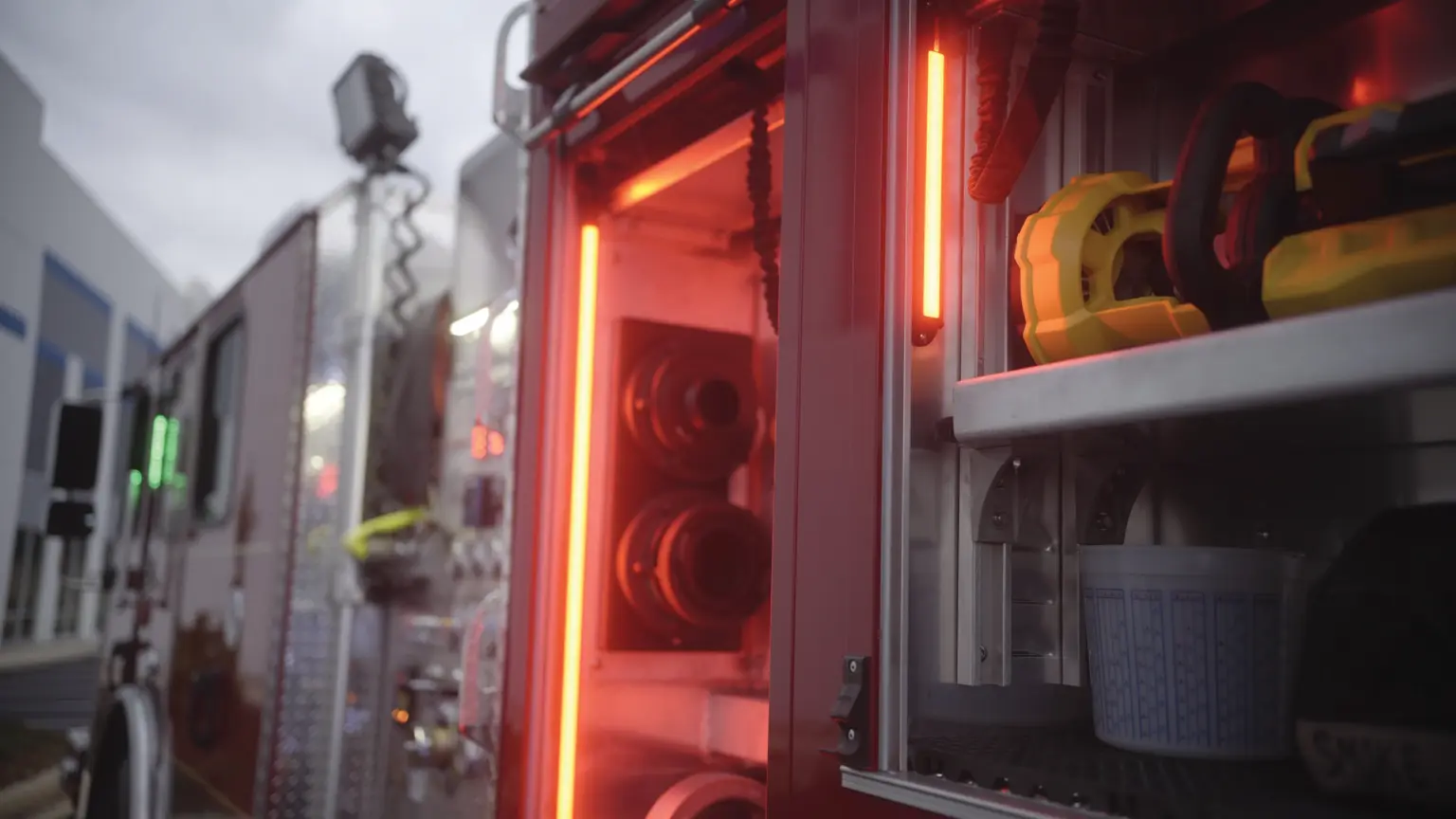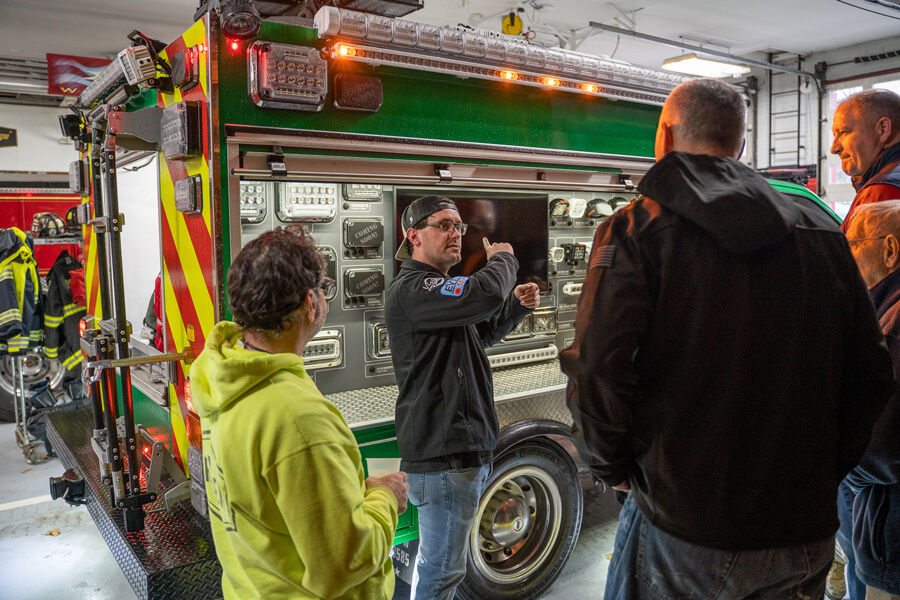Hey what’s up. It’s Sam from HiViz LED Lighting FireTech Lights.
So today, I’m going to do a little demo on compartment lights and we get asked all the time, “What makes a FireTech compartment light different or worth the money when comparing to the other types of compartment lights in the industry?”
Setting FireTech Compartment Lights Apart from the Competition
This is one of ours, we’ve taken it apart, so you can see the inside of it. I’ve actually got the end cap off. So, what are the 2 biggest differentiators for a FireTech’s LED Compartment Light? Easy: Durability and thermal management.
One, this thing is all aluminum, so the fixture itself is more durable than most compartment lights, but it gets into a lot deeper where we can dissipate heat a lot better, so the aluminum is great for of course the structure rigidity, but of course the thermal management as well.
3 LED Compartment Light Styles Around the Industry
Let me just show you a few styles. There are basically three styles.
1 – Cheap, Low Cost LED Compartment Lights
If you look at “Style 1,” this is kind of your cheaper LED compartment light.
It’s going to be a round poly tube that just goes on the inside and it’s clipped inside of the body. That poly tube has a circuit board, and that circuit board has LEDs on it and its usually a fiberglass circuit board. That circuit board runs the length of the compartment.
If you look at it from a side view, and this is the side view and it’s got — we put the circuit board this way, going inside and it’s clipped on to the body with a few plastic clips. The wiring comes in the top side. The circuit board clips together at the inside of those pins. So you can push it inside. When those pins get pushed together, the boards lock in place and it’s inside that poly tube.
That’s a low cost way to do it and it’s fine because these things are fairly bright. But the problem with this is that LED themselves dissipate heat off the back at the chip, so if the light is dissipating heat off the back at the chip and they are just on a fiberglass circuit board, then there is nowhere for that heat to go and then because that circuit board is inside of a plastic tube, it vibrates back and forth as a truck goes down the road.
The fiberglass itself is prone to failure and then the junction where that pins interact is prone to failure and then of course the whole thing being plastic just takes one good whack from a K12 and that thing is trash.
2 – Better Housing and Waterproofing, But Low Grade
The other, “Style 2” is a little bit better and this is the style where you’re having an aluminum extrusion, but the circuit board is cut and built in a whole long batch and then it’s cut in sections and put inside the housing.
What happens is these circuit boards are totally encapsulated in an epoxy batch.
Epoxy encapsulation keeps them from getting problems with water. It keeps them waterproof, but the problem with that is that the epoxy ends up an insulator and then of course you have a temperature problem, so let me just draw this out.
When you look at this type of extrusion, we’ve got a little pocket, and then we’ve got the rest of that pocket and this might go up.
So this type of extrusion, the circuit broad that sits in here slides in. The board sits in the middle of this epoxy encapsulation and it’s got LEDs on the top.
What happens here is the whole piece is sort of similar towards were it’s extruded, but the circuit board can’t get rid of the heat because this whole area around totally encapsulating around where the chips are is that epoxy, and epoxy is like a plastic and just like with anything, plastic is an insulator.
So this style is a lot better than “Style 1” because this is more durable. It’s more waterproof. It gives you a little more light up because it does have some strength to it.
3 – The FireTech Brand Approach to LED Compartment Lights
Meet “Style 3” — the FireTech style.
We take the circuit board and we built this thing more like we do with one of our scene lights, the FireTech Brow Light. The way our fixture goes, this is the housing right here.
If you look at it down the side, it’s shaped like a U. Sitting directly on the housing, is our circuit board. So on top of the circuit board, of course sits the LEDs. But the heat from these LEDs pushes back into the housing and this aluminum housing has ribs on it and those ribs act like a heat sink.
This whole big aluminum housing, because the circuit board is banded to the aluminum housing allows way better thermal dissipation and the key to the success of an LED over the life of an apparatus is the ability to manage the thermal load, the ability to shed heat.
The Problem with Standard LED Compartment Lights
Because typically, if LEDs get too hot, they break down and they just fail.
So the problem is when you band these together, now you’ve got big void space, you know water getting inside. With that knowledge, we went to work to build fire truck compartment lights that are durable and manage heat like no other on the market. Meet the FireTech Compartment Light solution.
The FireTech Compartment Light Solution
What we do is we epoxy and encapsulate once the fixture has been manufactured, up to the top half of the LEDs, so the board is banded to the housing and then we epoxy the top half and keep the open face, the phosphorus face of the LED out to the atmosphere.
But if you look here, you will see how that whole area will be covered in the epoxy potting, so that keeps it totally waterproof.
But then we also add a little ridge on the top side and have a gasket right here. If you look at this piece, actually that gasket of material goes on the topside and then we add a lens. That lens goes on top of the gasket when you pop it in place, it creates a waterproof seal.
We not only have a waterproof design where the circuit board is in an epoxy encapsulate, you also don’t get water on the LEDs. It also has a lens on top of it, it is waterproof, so the whole housing is designed to be used in higher vibration environments because you don’t have to worry about the “Style 1” type fixture problems, where the circuit broad rattles around inside of the piece of plastic tubing. It is designed for high temperature environments, so like a closed compartment or like a compartment even the underside of a fire truck, where we’ve got dirt, junk and trash, all over these things we’re able to dissipate heat because of these vents and the aluminum housing.
We’ve also got the durability of having all aluminum mounting points.
When you look at these, the lens gets installed on the top side and then we have an aluminum end cap. This light here has actually been on my truck for a couple of years and we just pulled it back for some testing, but this all aluminum end cap bolts into this extrude housing and when it’s bolted on, there is a little rubber gasket that goes over here.
It allows for mechanical fastening of the housing all the way to the fire truck body, so the likelihood of this thing getting knocked off the truck is very low because of this aluminum end cap and aluminum housing holding an aluminum circuit board all onboard.
The compartment in the fire truck, you can bang this thing as hard as you want with the K12s, because this thing is inside of the truck body, mechanically attached using aluminum and screws.
Anyway there is a lot of different types of compartment lights on the market, and I can’t say anybody builds a bad compartment light, but when it comes to FireTech compartment lights, we started with the design requirement. This thing will last for 25 years in service under a fire truck, on a fire truck or anywhere you put it.
This is the way we did it.
Contact a FireTech Brand Consultant Today!
For more information, check us out online at www.hivizleds.com. You can see the Guardian and rest of the FireTech brand scene lighting products. We can be reached by online contact form or call 703-662-3458.


